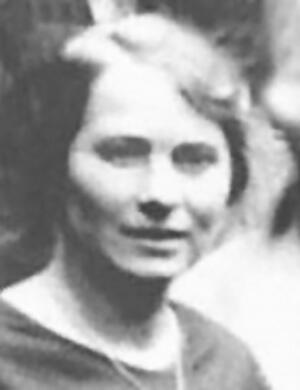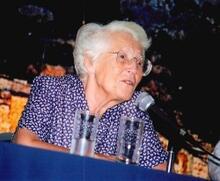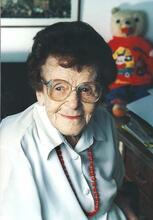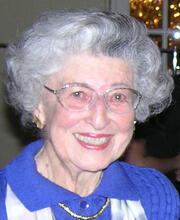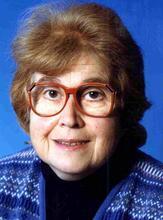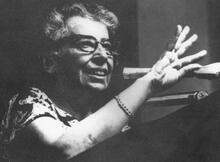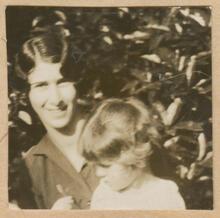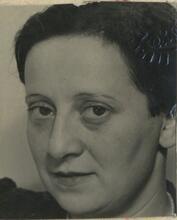Sabina Spielrein
Sabina Spielrein was born in 1885 in Russia and had a trauma-filled childhood with abusive parents and the death of her younger sister. She became the first patient of Carl Jung after being admitted to a psychiatric clinic in Zurich in 1904 and had an affair with Jung. She later obtained her doctorate and published the first psychoanalytically oriented dissertation written by a woman. She was a major figure in the development of the psychoanalytic movement – and a rare woman in that field. Her discoveries had a significant impact on theories that Jung and Freud developed.
Sabina Spielrein, a pioneer active in the early stages of the birth of psychoanalysis who made significant contributions to the field, was the first person to propose the thesis about instinctual life, which Freud later adapted. Spielrein determined that instinctual life was based on two instincts—the life instinct and the death instinct—which were opposed to each other. Spielrein’s contributions to the early development of psychoanalysis have been overlooked and, until recently, mainly forgotten. In the mid–1970s, papers pertaining to Spielrein, including diaries and correspondence, which were found hidden in a basement in Geneva revived interest in her. Unfortunately, much of the recent work on Spielrein has focused on her role in a triangle with Freud and Jung, rather than on her own specific contributions.
Childhood
Sabina Spielrein was born on November 7, 1885, in Rostov-on-Don, Russia. She was the oldest of five children. Her father, Naphtul Arkadjevitch Spielrein, was a merchant, and her mother, Emilia (Eva) Marcovna Lujublinskaja, was a dentist. Spielrein’s maternal grandfather and great-grandfather were both rabbis. Her grandfather educated Spielrein’s mother, who was very intelligent and musical. However, after she became engaged to a Christian, her father arranged the marriage with Spielrein’s father, who was Jewish. It was not a marriage Spielrein’s mother wanted, nor does it appear that she and her husband ever fell in love or enjoyed a satisfying relationship.
The parents, who were extremely strict, forced the children to endure an extremely harsh upbringing: her father tyrannized the household; her mother beat the children severely. Nevertheless, they placed great emphasis on the children’s education, employing a nursemaid, a governess to prepare them for high-school entrance, and a music teacher.
Spielrein was a very delicate and sensitive child, subject from infancy to frequent illness. She was also very precocious. While Russian was her first language, by the age of six Spielrein also spoke German and French. Indeed, the entire household communicated in a different language every day of the week, moving between German, French, English, and Russian.
At the age of ten, Spielrein began attending a girls’ grammar school in her hometown, completing her studies with distinction in 1904. She lived at home with her parents, three brothers (Jean, Isaak and Emil), and one sister, Emilia. In addition to her coursework, Spielrein studied piano. At the age of twelve, she started studying Latin and voice. She very much enjoyed natural science courses and decided that the direction in which she wanted to move was medicine. When Spielrein was fifteen, her six-year-old sister died of typhoid. This episode had a dramatic effect on Spielrein.
Mental Health Treatment
Spielrein’s mental health “affliction” appeared at age seventeen, although she had been beset with problems throughout her young life. She was taken to Heller Sanatorium, Interlaken, in Switzerland for one month, and was admitted to the Burghölzli Treatment and Care Institution (or Psychiatric Clinic) in Zurich on August 17, 1904. Spielrein became the first patient of Carl Jung, ten years her senior, who treated her until her discharge on June 1, 1905.
Given what has been learned since 1905 regarding a young person’s reaction to extreme trauma, many of the symptoms Spielrein exhibited would be more “normalized” today as natural responses to severe, prolonged trauma. Many of the abnormalities Jung noted in Spielrein’s records are now more easily recognized and understood by trauma specialists.
Following Spielrein’s discharge, she began studying medicine at the University of Zürich. Professor Eugen Bleuler, the head of the Burghölzli Clinic, provided a typed medical certificate for the university recommending her admittance. He stated that Spielrein had not been under treatment for mental illness at the Burghölzli Clinic, but that she had been suffering symptoms that were hysterical in nature, as part of a nervous condition. She remained an out-patient in treatment with Carl Jung for years after her hospital discharge.
Affair with Carl Jung
Sabina Spielrein fell deeply in love with Jung during her treatment, a love that she knew must remain secret due to his marriage and the ethics of his profession. Jung was first attracted to Spielrein at Burghölzli. In the records at Burgholzli Hospital on his treatment of Spielrein, Jung wrote an entry in his own handwriting on January 29, 1905. He states that he had visited Spielrein the previous night, “reclining on the sofa.” He describes her manner as “oriental” and “voluptuous,” and her face as bearing “a sensuous, dreamy expression” (Covington and Wharton, 96.) Both Spielrein and Jung’s feelings for each other continued to deepen in subsequent years. They shared a passionate interest in psychoanalysis that further bonded them. Spielrein was delighted in the parallelism that existed in their thoughts. The result was a stormy love affair between them that continued until the spring of 1909. To what degree the relationship was sexual remains a hotly debated subject.
Jung eventually ended the affair, to save his marriage and his career. A rumor was maliciously circulated in Vienna and Zurich about an affair he allegedly had with a student. Initially, both Jung and Freud thought Spielrein was the origin of the scandal as an act of revenge against Jung for ending their relationship. Together, Jung and Freud plotted against her. However, it turned out that they had accused her unjustly. Spielrein had nothing to do with the slander of Jung.
Spielrein’s case appears to be at least part of what motivated Jung to initially contact Freud. Jung had been greatly impressed by some of Freud’s innovative techniques and writings, and applied them to his treatment of Spielrein. Jung wrote to Freud in October 1906 seeking his opinion about a challenging case he had involving a young female Russian student. Spielrein also sought help from Freud, initially requesting a consultation with him in 1909, but Freud declined due to his discussions with Jung about his relationship with Spielrein. Spielrein eventually met Freud in Vienna in October 1911. He was greatly impressed with her.
Psychology Work
In May 1911, Spielrein obtained her doctorate. Her study, “Concerning the Psychological Content of a Case of Schizophrenia,” was the first dissertation written by a woman that was psychoanalytically oriented. It was published in 1911 as the lead paper in the Jahrbuch der Psychoanalyse, which was edited by Jung. At the meeting of the Vienna Psychoanalytic Society (WPV) on October 11, 1911, she was elected to membership as the second female doctor. She became an active member of the society, attended its Wednesday meetings, gave lectures, and published numerous papers. Freud even sent her patients. But this was not enough to keep her afloat financially. Unable to earn a living in Vienna, she returned to Berlin.
Spielrein met Dr. Pavel (Paul) Naumovitsch Scheftel, a Russian Jewish physician, and they were married on June 14, 1912. In December 1913 she gave birth to her first daughter, Irma Renata. Spielrein continued to correspond with Jung and Freud during this time, despite the destructive split that occurred between the two men in 1912. She corresponded with Jung until at least 1919 and with Freud until 1923.
Shortly after World War I broke out, Spielrein was back in Switzerland. She had difficulty finding a place where she could settle down and practice and was plagued with financial worries. Her husband was nowhere in sight. In 1920 in The Hague, Spielrein spoke at the sixth International Psychoanalytic Congress. She shared her new theory about child development, including children’s speech, and discussed the importance of suckling and the mother’s breast. Her theory had a profound influence on Melanie Klein, who also attended the Congress. Spielrein then moved to Geneva for work at the Jean-Jacques Rousseau Institute, where she spent her last three years in Switzerland. She lectured and did clinical work, but her most renowned work there was her treatment of Jean Piaget in 1921 as his analyst for eight months. She also wrote part of a novel and wrote theater criticism for the Journal de Genève, but she was unable to make an adequate living.
In 1923 Spielrein returned to Russia to visit family and colleagues. She lived in Moscow and from September 1923 worked with colleagues on a training program at the Moscow Psychoanalytic Institute. At the same time, she became director of the child psychology department at the First Moscow University and served as pedagogical doctor at the Third International, a kind of children’s village.
Spielrein returned to her hometown of Rostov-on-Don in about 1924 and reunited with her husband. Although he had returned earlier, they had been separated for several years. He had fathered a child with another woman and had been living with her. In 1926, Spielrein gave birth to a second daughter, Eva. Back in her hometown, Spielrein founded a psychoanalytic children’s nursery and taught at the university until 1936, when Stalin banned psychoanalysis. Her brothers, who had meanwhile developed academic careers, were arrested under Stalin’s reign of terror and killed in a Gulag.
Death Legacy
Spielrein’s death remained a mystery until 1983 when M. Ljunggren, a Swedish journalist, discovered her fate: In 1942, together with both her daughters, Spielrein was shot as a Jew by Germans who had captured Rostov for a second time on July 27. Neighbors saw her being herded with other Jews, including Eva and Renata, toward the “Snake Ravine” (Zmieva Balka) just outside the city, where men of Einsatzkommando 10a from Einsatzgruppe D killed them. Her husband had died a few years earlier.
Spielrein published thirty psychoanalytic papers in French and German. The majority of them have not yet been translated into English. Her two most significant works were her dissertation on schizophrenia, which contributed greatly to understanding the language of schizophrenics, and her second work, “Destruction as the Cause of Coming into Being.”
The oblivion into which Spielrein has fallen is remarkable. She was a major figure in the development of the psychoanalytic movement—and a rare woman in that field. Her thought and work had significant impact on the theories Jung and Freud developed. Spielrein has been considered by some as the model for Jung’s concept of the anima. She deepened both Jung and Freud’s understanding of transference and countertransference. The relationship between Jung and Spielrein also demonstrated to Freud that a therapist’s emotions and humanity could not be kept out of the psychoanalytic relationship between analyst and patient. Freud had been hopeful that, as scientists, psychoanalysts would be able to function from an objective and neutral position in their work.
It is hard to explain the oblivion into which Spielrein fell until recently. Neither Ernest Jones in his standard work on Freud (1953), nor Peter Gay’s magnum opus, Freud (1987), nor even Nancy Chodorow, who wrote on the contribution of women to psychoanalysis (1987), mention her in their writings. Her primary role in child psychology has been wrongly attributed to Anna Freud or, alternatively, to Melanie Klein.
There are many parts of Sabina Spielrein’s life that remain a mystery and there is continued controversy regarding specific dates and activities in her life. One can only hope that more of her story will be discovered and that more research will focus on the work that Spielrein did personally. She faced many obstacles, both because she was a woman working in a predominantly male profession and because she was Jewish during a period of violent antisemitism. Her tragic death cut short a life of promise.
Selected Works
“Über den psychologischen Inhalt eines Falles von Schizophrenie (Dementia Praecox).” Jahrbuch für psychoanalytische und psychopathologische Forschungen (1912): 3:329–400.
“Die Destruktion als Ursache des Werdens.” Johrbuch für psychoanalytische und psychopathologische Forschungen (1912) 4:465–503.
“Beiträge zur Kenntnis der Kindlichen Seele.” Zentralblatt für Psychoanalyse und Psychotherapie (1912) 3:57–72.
“Mutterliebe.” Imago (1912) 2:523–24.
“Selbstbefriedigung in Fusssymbolik.” Zentralblatt für Psychoanalyse und Psychotherapie (1913) 3:263.
“Traum vom Vater Freudenreich.” Internationale Zeitschrift für ärztliche Psychotherapie (1913) 1:484–486.
“Das unbewusste Träumen in Kuprins Zweikampf.” Imago (1913) 2:524–525.
“Die Schwiegermutter.” Imago (1913) 2:589–591.
“Der vergessene Name.” Internationale Zeitschrift für ärztliche Psychoanalyse (1914) 2:383–384.
“Tiersymbolik and Phobie bei einem Knaben.” Internationale Zeitschrift für ärztliche Psychoanalyse (1914) 2:375–377.
“Zwei Mensesträume.” Internationale Zeitschrift für ärztliche Psychoanalyse (1914) 2:32–34.
“Ein unbewusster Richterspruch.” Internationale Zeitschrift für ärztliche Psychoanalyse (1915) 3:350.
“Die Äusserungen des Oedipuskomplexes im Kindersalter.” Internationale Zeitschrift für ärztliche Psychoanalyse (1916) 1:44–48.
“Das Schamgefühl bei Kindern.” Internationale Zeitschrift für ärztliche Psychoanalyse (1920) 6:157–158.
“Zur Frage der Entstehung und Entwicklung der Lautsprache.” Internationale Zeitschrift für ärztliche Psychoanalyse (1920) 6:401.
“Das Schwache Weib.” Internationale Zeitschrift für ärztliche Psychoanalyse (1920) 6:158.
“Verdrangte Munderotik.” Internationale Zeitschrift für ärztliche Psychoanalyse (1920) 6:361–362.
“Renatchens Menschenentstehungstheorie.” Internationale Zeitschrift für ärztliche Psychoanalyse (1920) 6:155–157.
“Russische Literatur.” Bericht über die Fortschritte der Psychoanalyse 1914–1919, Vienna: Internationaler Psychoanalytischer Verlag, 1921.
“Schnellanalyse einer kindlichen Phobie.” Internationale Zeitschrift für ärztliche Psychoanalyse (1921) 7:473–474.
“Briefmarkentraum.” Internationale Zeitschrift für ärztliche Psychoanalyse, (1922) 8:342–343.
“Qui est l’auteur du crime?” Journal de Geneve 2 (January 15, 1922).
“Die Entstehung der kindlichen Worte Papa und Mama.” Imago (1922) 8:345–367.
“Schwiez.” Internationale Zeitschrift für ärztliche Psychoanalyse (1922) 8:234–235.
“Rêve et vision de étoiles filantes.” International Journal of Psycho-Analysis (1923) 4:129–132.
“Die drei Fragen.” Imago (1923) 9:260–263.
“L’automobile: Symbole de la puissance male.” International Journal of Psycho-Analysis (1923) 4:128.
“Ein Zuschauertypus.” Internationale Zeitschrift für ärztliche Psychoanalyse (1923) 9:210–211.
“Quelques analogies entre la pensée de l’enfant, celle de l’aphasique et la pensée subconsciente.” Archives de psychologie (1923) 18:306–322.
“Einige kleine Mitteilungen aus dem Kinderleben.” Zeitschrift für Psychoanalytische Pädagogik (1923) 2:95–99.
“Die Zeit im unterschwelligen Seelenleben.” Imago (1923) 9:300–317.
“Kinderzeichnungen bei offenen und geschlossenen Augen.” Imago (1931) 16:259–291.
“Destruction as the Cause of Coming into Being.” Journal of Analytical Psychology 39 (1994) 2:155–186.
“The origin of the child’s words ‘papa’ and ‘mama.’ Some observations on the different stages in language development.” In Sabina Spielrein: Forgotten Pioneer of Psychoanalysis, edited by Coline Covington and Barbara Wharton, 287–305. New York: Routledge, 2003.
Carotenuto, Aldo. A Secret Symmetry: Sabina Spielrein Between Jung and Freud. New York: Pantheon Books, 1982.
Covington, Coline, and Barbara Wharton, eds. Sabina Spielrein: Forgotten Pioneer of Psychoanalysis. New York: Routledge, 2003.
Kerr, John. A Most Dangerous Method: The Story of Jung, Freud, and Sabina Spielrein. New York: Vintage, 1993.
Film
Ich hiess Sabina Spielrein (My name was Sabina Spielrein). Sweden: 2002.

